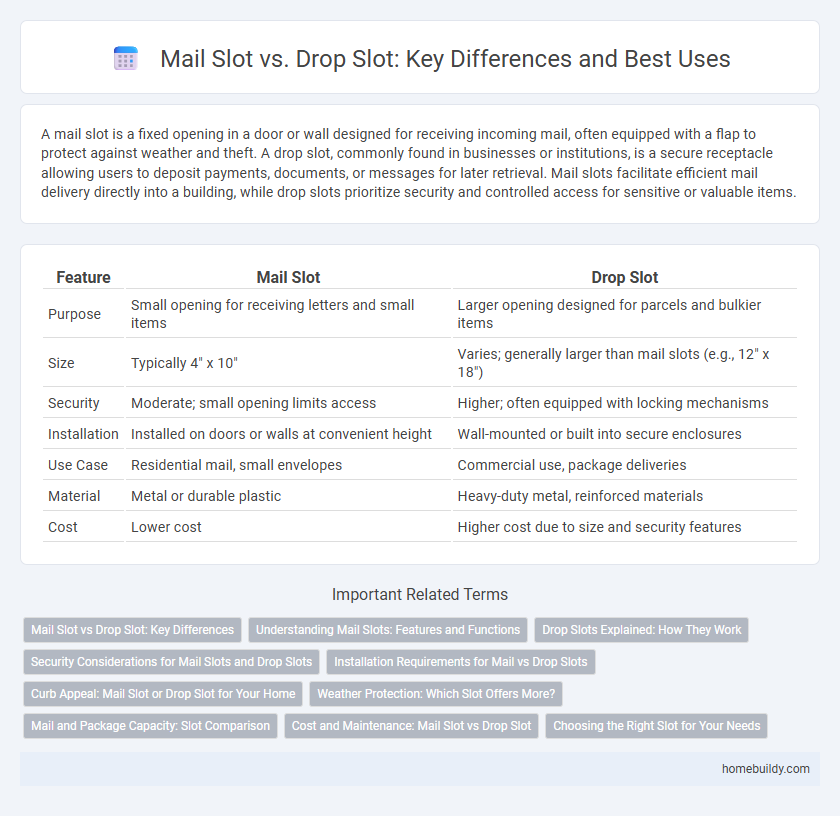A mail slot is a fixed opening in a door or wall designed for receiving incoming mail, often equipped with a flap to protect against weather and theft. A drop slot, commonly found in businesses or institutions, is a secure receptacle allowing users to deposit payments, documents, or messages for later retrieval. Mail slots facilitate efficient mail delivery directly into a building, while drop slots prioritize security and controlled access for sensitive or valuable items.
Table of Comparison
| Feature | Mail Slot | Drop Slot |
|---|---|---|
| Purpose | Small opening for receiving letters and small items | Larger opening designed for parcels and bulkier items |
| Size | Typically 4" x 10" | Varies; generally larger than mail slots (e.g., 12" x 18") |
| Security | Moderate; small opening limits access | Higher; often equipped with locking mechanisms |
| Installation | Installed on doors or walls at convenient height | Wall-mounted or built into secure enclosures |
| Use Case | Residential mail, small envelopes | Commercial use, package deliveries |
| Material | Metal or durable plastic | Heavy-duty metal, reinforced materials |
| Cost | Lower cost | Higher cost due to size and security features |
Mail Slot vs Drop Slot: Key Differences
Mail slots are typically integrated into doors or walls, designed for securely receiving standard-sized mail items directly into a building, while drop slots are often larger openings intended for depositing bulkier packages or multiple types of deliveries. Mail slots provide a more compact and secure option for everyday postal items, minimizing exposure to weather and theft, whereas drop slots offer greater versatility for various shipment sizes but may require additional internal collection compartments. Understanding the size, security features, and installation locations are crucial when deciding between a mail slot and a drop slot for residential or commercial use.
Understanding Mail Slots: Features and Functions
Mail slots are built into doors or walls, allowing secure, direct delivery of letters and small packages without requiring the recipient to open the door. Unlike drop slots, which are typically larger and designed for bulkier items, mail slots prioritize convenience and efficiency for everyday mail, featuring weather-resistant flaps and internal collection containers. The functionality of mail slots enhances security by reducing exposure to theft and the elements, making them a practical choice for residential and business mail management.
Drop Slots Explained: How They Work
Drop slots function by allowing items to be securely deposited through a narrow opening that leads to a locked compartment, providing enhanced security compared to traditional mail slots. Unlike mail slots, drop slots often feature tamper-resistant designs and are constructed from durable materials such as stainless steel to prevent unauthorized access. These characteristics make drop slots ideal for confidential document handling and secure package deliveries in residential and commercial settings.
Security Considerations for Mail Slots and Drop Slots
Mail slots and drop slots differ significantly in security features, with mail slots often posing higher risks due to their exposed design, which can allow unauthorized access or tampering. Drop slots typically incorporate secure collection boxes that prevent mail theft and protect against environmental damage, enhancing overall security. Selecting a drop slot with reinforced materials, anti-fishing baffles, and tamper-resistant locks can greatly improve mail security compared to traditional mail slots.
Installation Requirements for Mail vs Drop Slots
Mail slot installation requires precise cutting into the door or wall, typically adhering to specific size and height regulations to ensure secure and weather-resistant access for incoming mail. Drop slot installation often demands reinforced framing and additional security features to prevent tampering, with varied placement options including walls or dedicated drop boxes based on building codes. Both installation types must comply with local postal service standards and accessibility guidelines to guarantee functionality and user safety.
Curb Appeal: Mail Slot or Drop Slot for Your Home
Mail slots offer a sleek, integrated look that maintains a clean exterior surface, enhancing curb appeal by blending seamlessly with door designs. Drop slots, often bulkier and mounted externally, can disrupt the facade's smooth lines and may require additional hardware or frames that draw attention. Homeowners prioritizing minimal visual impact typically prefer mail slots to preserve the aesthetic integrity of their entryway.
Weather Protection: Which Slot Offers More?
Mail slots provide superior weather protection by being integrated directly into the door, minimizing exposure to rain, wind, and snow. Drop slots, often installed in walls or fences, tend to have larger openings that can allow moisture and debris inside. Proper sealing and design in mail slots ensure better insulation and reduced risk of water damage compared to drop slots.
Mail and Package Capacity: Slot Comparison
Mail slots typically accommodate standard letters and small envelopes, making them ideal for everyday mail delivery. In contrast, drop slots are designed with larger dimensions, allowing them to hold both mail and bulky packages securely. The increased capacity of drop slots enhances convenience for receiving parcels, reducing the need for multiple deliveries or pickups.
Cost and Maintenance: Mail Slot vs Drop Slot
Mail slots generally offer lower installation costs and minimal ongoing maintenance due to their simple design and integration into doors or walls. Drop slots, often requiring more robust materials and secure enclosures, typically incur higher initial expenses and periodic upkeep to ensure security and functionality. Choosing between mail slots and drop slots depends on balancing budget constraints with desired durability and maintenance frequency.
Choosing the Right Slot for Your Needs
Mail slots offer direct indoor delivery, ensuring mail is securely received inside your home, while drop slots typically deposit items into an external box or container. Selecting the right slot depends on security preferences, mail volume, and installation location with mail slots favored for convenience and drop slots preferred for larger packages. Consider the size and type of mail you receive regularly to choose a slot that balances accessibility with protection against weather and theft.
mail slot vs drop slot Infographic

 homebuildy.com
homebuildy.com